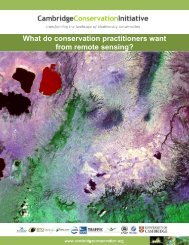CONSERVING BIODIVERSITY & DELIVERING ECOSYSTEM SERVICES
conserving biodiversity & delivering ecosystem services
conserving biodiversity & delivering ecosystem services
Create successful ePaper yourself
Turn your PDF publications into a flip-book with our unique Google optimized e-Paper software.
Forests, grasslands,<br />
wetlands and the high<br />
mountains are all important<br />
habitats for Nepal’s<br />
spectacular wildlife,<br />
appreciated by people<br />
everywhere and provide a<br />
range of ecosystem services<br />
which are integral to the<br />
livelihoods of local<br />
communities.<br />
Forests: In Nepal, forests cover nearly 40% of the land area and provide a number of important<br />
ecosystem services, including provision of goods such as timber and fuelwood and local<br />
climate and water regulation. Forests also have great cultural and spiritual importance, as<br />
places of pilgrimage, and store large amounts of carbon in their living biomass, thereby<br />
playing a role in global climate regulation by reducing net ‘greenhouse gas’ emissions to the<br />
atmosphere. They are a very important habitat for wildlife—over half of the nationally<br />
threatened bird species occur in forest. However, there are a number of trade-offs associated<br />
with the use of forest services, particularly in relation to production values. Enhancing one<br />
service, for example the supply of timber, through conversion of natural forest to plantations<br />
will affect other services, such as harvested wild goods and nature-based tourism.<br />
Grasslands: In Nepal, natural grasslands cover approximately 14% of the land area, ranging<br />
from subtropical savannas in the flood plains and terraces of the Terai to temperate grasslands<br />
and alpine meadows in the cold, arid steppe of the Himalayas. Grasslands are integral to the<br />
livelihoods of local communities, for example through providing grazing for livestock, as a<br />
source of medicinal and aromatic plants, and supporting populations of prey species (e.g.<br />
ungulates) for predators such as tigers. The spread of cultivation in Nepal’s lowlands has led to<br />
the once extensive lowland grasslands becoming greatly reduced and fragmented. Today,<br />
grasslands only exist in their natural state within protected areas in the Terai. Here they are still<br />
home to a huge number of birds, including the globally threatened Bengal Florican and<br />
Swamp Francolin, and threatened mammals such as the Indian Rhinoceros, Tiger and Asian<br />
Elephant. Higher altitude grasslands are also home to a diverse range of wildlife, providing<br />
forage for wild ungulates such as Wild Yak and Himalayan Tahr.<br />
Wetlands: There are many wetlands in Nepal providing critical services to local people, including<br />
fodder for livestock and fibre for building, helping to regulate and purify water flows, often<br />
reducing the risk of flooding and enabling clean water to be accessed year-round. They are also<br />
an important habitat for large numbers of migratory birds and other wetland-dependent species,<br />
such as Asian Water Buffalo and Ganges River Dolphin. Many wetlands are under severe pressure<br />
from drainage and reclamation, inappropriate use or fisheries management, and water extraction.<br />
High mountains: The high altitude mountain habitats of Nepal include large alpine and semidesert<br />
areas, as well as extensive areas of temperate forest. The Himalayas have great beauty<br />
and grandeur, holding spiritual and cultural value for the people living in and around them and<br />
for the thousands of visitors who travel to the region every year. Mountain dwellers, who<br />
comprise 7% of Nepal’s population are particularly heavily dependent on natural resources,<br />
perhaps more so than people in other regions of Nepal. Mountain ecosystems are also very<br />
susceptible to environmental pressures, with changes in the climate and provision of ecosystem<br />
services having significant impacts on local communities as well as those living downstream.<br />
Nepal’s rich biodiversity and its varied ecosystems, such as forests, grasslands, wetlands and high mountains, provide<br />
vital services and livelihoods for people (clockwise from top left: David Thomas, Jyotendra Jyu Thakuri, Andy Graham, Hum Gurung)




